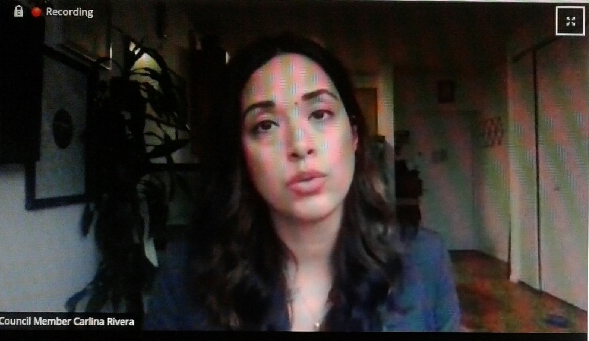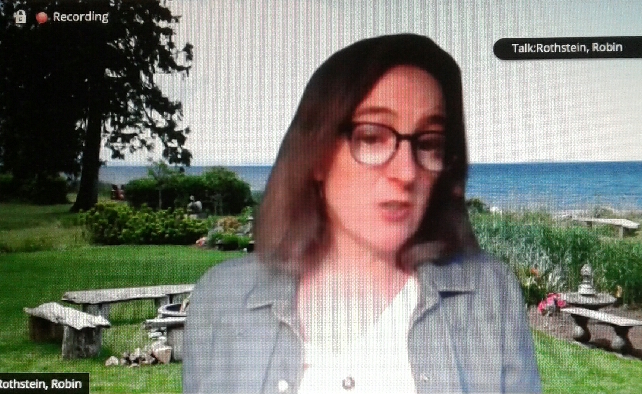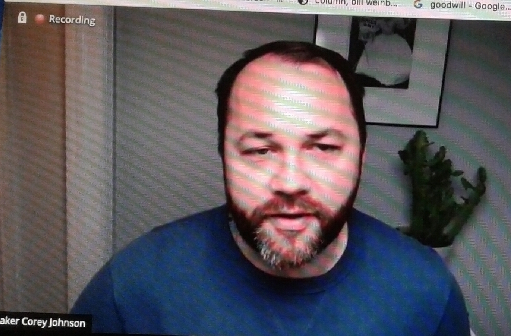BY LINCOLN ANDERSON | Soho may be off the table for the city’s open streets program, but Community Board 2 last Thursday O.K.’d nine streets elsewhere — mainly in the Central Village and West Village, plus one in the Meatpacking District — as candidates for the new initiative.
Ultimately, though, only a few of the streets are likely to be chosen for the program.
Three days earlier, the C.B. 2 Traffic and Transportation Committee had bowed to pressure from outraged Soho residents, who fought to keep Broadway, West Broadway and Prince and Mercer Sts. out of the program. Locals had flooded the committee with 150 letters against the idea and then turned out in force, “packing” the Zoom virtual meeting.
Speaking at the time, Shirley Secunda, the committee’s chairperson, said C.B. 2 did not want to force open streets onto a community that did not want them.
The open streets program was pushed hard by Speaker Corey Johnson and Councilmember Carlina Rivera, over Mayor de Blasio’s hesitation, after Johnson threatened to get the governor to back the plan.
The sticking point had been whether police were needed to provide security for the program. But an agreement with the mayor was reached under which “community partners” — such as business improvement districts — are supposed to play that role.
The initial aim is to create 40 miles of streets citywide for people to get outside while safely social distancing — with a goal of eventually boosting that to 100 miles.
The program is billed as temporary. But many Soho residents worried it would have been a Trojan horse to create permanent pedestrian malls to attract even more shoppers and tourists to the area. There was also fear that people using the open streets would not wear face masks, putting older and immunocompromised Soho residents at risk.
Meanwhile, speaking at last Thursday’s full board meeting, some C.B. 2 members and local residents noted it’s nearly impossible to walk down the Village’s narrow sidewalks while social distancing.
“On sunny days I just stay home because it’s not worth the stress,” board member Georgia Silvera Seamans said. To keep 6 feet away from people, she said, “You have to step off the sidewalk or do some kind of dance.”
Samir Lavingia, a Google software designer living in the West Village, has been advocating strongly for the open streets program at the C.B. 2 meetings. Pointing to the need for more car-free space right now, he said his girlfriend was jogging when she rolled her ankle while hopping up and down from the sidewalk to the street trying to do social distancing.

However, Rocio Sanz, a Board 2 member who owns Tio Pepe restaurant on W. Fourth St., was skeptical the measure is needed.
“There is very little traffic in the Village right now,” she scoffed.
David Gruber, a former board chairperson likes the idea of more space for pedestrians — but not for bikes.
“I don’t want it to be a bike highway,” he stressed of the open streets. “I like the idea of kids learning to ride their bikes there. But I don’t want to see bikes everywhere, that’s going to ruin it for pedestrians, and it’s not going to be good for seniors.”
Gruber also said open streets in the Village won’t just be used by locals, even though other neighborhoods around the city will have their own open streets.
“We will be a destination,” he said, noting how the Village’s restaurants are always a big draw.
In addition, Gruber said he’d like to see Soho have some open streets of its own, feeling that all parts of Board 2 should have their fair share.
The revised preliminary list of open streets recommended by C.B. 2 for the program includes University Place between W. Fourth and E. 13th Sts.; MacDougal St. between W. Eighth and Houston Sts.; Greenwich St. between Horatio and Barrow Sts.; Sullivan St. between W. Fourth and Houston Sts.; Thompson St. between W. Fourth and Houston Sts.; 13th St. between Eighth and Ninth Aves.; Gansevoort St. between 13th St. and Ninth Ave.; Barrow St. between Washington Place and West St.; and Bank St. between West St. and Greenwich Ave.
Some of these, like MacDougal St. and University Place, are next to parks, which is one of the program’s main criteria — to relieve pressure on overcrowded parks.
However, it’s the city that will ultimately pick which streets go into the program. Ritu Chattree, a Traffic and Transportation Committee member, added that only a few of the streets the board suggests will be chosen since each district will get only a limited number of open streets.
“This is an iterative process,” she said. “These are just suggestions, most of which will be discarded. Our resolution itself says the list is preliminary.”
The discussion of the open streets — specifically, “additions” to the C.B. 2 list — will continue at this month’s Traffic and Transportation Committee meeting on Thurs., May 7.
For its part, Board 2 supports a so-called “shared streets” model, under which the street is partially closed to vehicles while pedestrians are given priority; meanwhile, vehicle access is allowed at 5 miles per hour for first responders, deliveries, sanitation, Access-a-Ride and other essential services, plus local residents’ vehicles.
C.B. 2 also favors — as the City Council also reportedly does — the idea of closing at least one lane on a street to vehicle traffic to extend the sidewalk space from the curb.
The city kicked off the program last Friday — pushing up the planned start a few days — closing 7 miles of streets, including roads inside parks, to cars. None were in Downtown Manhattan.

Johnson and Rivera virtually attended last Thursday’s C.B. 2 meeting, reporting on what they’ve been working on, and answering questions about the open streets.
C.B. 2 Chairperson Carter Booth asked Rivera what exactly “temporary” means in regard to the open streets.
Rivera explained it means “right now.”
“The bill says it’s for the duration of the crisis,” she said, “and there will be a review in a month or so. … It can be like a pilot program,” she noted.
Rivera added the program could also be used to help restaurants put tables out on the street once businesses reopen.
“Can this be a solution for our restaurants — to be like al fresco dining?” she offered.
Booth later asked if it was the Soho Broadway Initiative, a BID, that had previously pushed for Broadway and other Soho streets to be open streets. Janet Liff, a Traffic and Transportation Committee member, denied that. Liff is a board member of Transportation Alternatives and chairperson of TransAlt’s Manhattan Committee.

Speaking to the need for open streets, there was also a lot of discussion about crowding in Hudson River Park, as well as on the adjacent bike path.
Robin Rothstein, another board member, said she’s been cycling a lot on the bike path lately for exercise during the lockdown, but finding it very crowded, especially at certain narrow pinch points. Johnson said open streets could help relieve the pressure on the river bike path.
“I’ve been getting complaints from Westbeth and the West Village Houses about the park being crowded and joggers running without masks and no chance for social distancing,” he said. “Before the pandemic hit, it was the busiest greenway in America. Now with the pandemic in effect, it is way busier than it was before.”
It was noted that Tony Simone, external affairs director for the Hudson River Park Friends, sent the board a letter expressing the group’s support for open streets.
“We are seeing unprecedented pressure on our parks and open spaces,” the letter stated.
The Friends are advocating for making both Washington and Greenwich Sts. open streets, and even closing a southbound lane of the West Side Highway to vehicle traffic to give people more open space.
This past weekend, tickets were being issued in parks for groups not social distancing. The mayor reportedly told Police Commissioner Dermot Shea to send officers to Hudson River Park after complaints there of crowding.
Assemblymember Deborah Glick, who also joined the Zoom meeting, said runners absolutely must wear face masks.
“If you choose to run, it’s not just 6 feet, it’s 12 to 20 feet behind you,” she said of the virus-packed droplet clouds that maskless joggers potentially are spewing in their wake. “It’s selfish and reckless,” she said.
Meanwhile, some runners say people’s yelling at them to don masks is harshing their fitness routine, but that it’s probably just generalized anxiety about the pandemic.
Obviously, it’s much easier to catch the virus in enclosed spaces and through prolonged contact, which is why the main way it spreads is through families. But people don’t want to take chances with this potentially deadly disease.
Glick also said the greenway needs to be widened to alleviate the crowding.
Katy Bordonaro, a C.B. 2 member who is immunocompromised, voiced her alarm at seeing so many CitiBike riders without masks. She said she’d like to see signs posted prominently at bike-share docks telling cyclists to wear them, in accordance with New York law under Governor Cuomo’s executive order.
Glick noted the mayor has stated he doesn’t want to ticket people for not wearing masks, but now it’s time for some enforcement already.
“I do think,” she said, “it’s reached the point where you’ve had two months to figure it out, Jack, and it’s time to come down with the hammer.”


Hi Sean, just clarifying a few things. After that I’m done, even if more comes in that I disagree with, because the Open Streets guidelines just issued by DOT render this conversation obsolete. 1. You never asked me for the names of the people in SoHo who requested open streets in their neighborhood. Any correspondence that comes into CB2 becomes public knowledge, not a secret at all. 2. The SoHo Broadway BID, being a part of the CB2 community, is well within bounds in submitting any suggestions for District 2. 3. Prince St. was one of the submissions received, so likely discussed in committee. Thanks for recognizing the committee’s fairness.
“ Glick also said the greenway needs to be widened to alleviate the crowding.”.
Wonderful idea! Removing one moving lane can create more space for people to ride bicycles on and relieve more space for people to walk on the greenway.
The main problem is that bikers not only race along the streets, they make no warning sounds at all (they should, especially since the delivery people and others come up ridiculously fast). They also swerve back and forth and a few even enjoy coming straight at pedestrians as a “joke” or intentionally to frighten them. In fact they already make crossing streets perilous, and it’s likely that a good number of cyclists will behave as if the “open” streets were created to be their raceways. Who is going to stop them? They don’t have licenses and the police have plenty of work as it is. A lot of seniors have been hurt by speeding cyclists.
Mr. Sweeney should get his facts straight. CB2 sent out a notice to the entire CB2 community well in advance of the Traffic & Transportation Committee’s 4/27 meeting asking community people to submit their preferences/suggestions for open streets in their areas, to be discussed at the T&T Committee meeting. The SoHo Broadway BID letter was in response to that notice to which several other people from SoHo also responded in favor of “open streets” and with their enthusiastic suggestions. The SoHo Broadway BID, being a part of the CB2 community, is on the CB2 mailing list, and the BID responding to the notice was entirely appropriate. It’s a shame that the SoHo folks who saw the need for “open streets” to facilitate their physical distancing and give them better walking conditions in their streets had to be deprived of this small comfort.
Shirley, for the past week I have been trying to find out which “people in SoHo” requested the street closings. No one I know. You wouldn’t tell me. What’s the big secret?
A Greenwich Village member of your own committee admitted he suggested Prince Street, right? So who suggested the other streets?
And if there were so many “people in SoHo” who wanted closed streets, why did only one person testify in support at your committee hearing last week? Where were the rest of these alleged SoHo residents?
I’ve been trying to find out from the CB office where the suggestions originated (without luck). I wouldn’t be at all surprised if not a one came from the neighborhood but were suggested by folk who don’t live here.
Lots of people want closed streets, just as long as it is not theirs.
Finally, some 150 SoHo/NoHo residents opposed the proposal. The board office told me that they received about 15-20 in support. Sorry, but a 90% majority should have its voice heard, not the other way around.
You didn’t address my point that the Broadway SoHo BID requested not only Broadway, but also Prince, Spring, Broome, Grand and Howard – streets not within their legal boundary.
But I do want to commend you and the committee for acting in a democratic fashion and listening to the requests of the vast majority of people in SoHo/NoHo opposed this ill-conceived plan.
What a sad day for our community.
NIMBY ism prevails
Soho , my neighborhood , has the mistaken impression our streets are not meant for the city at large.
Fear of how this will all work/ open streets is a fear that will only hold back health safety.
It won’t actually happen, but I think everyone should embrace the spirit of open streets and stop think only of obstacles.
Yesterday was a summery days. The streets/ local parks were so active you would almost think there was no sheltering in place. Maybe 1/3 people wearing masks.
Embrace well being. Enable social distancing on our streets. Don’t bog things down and belabor the process When this finally ends, that should be our legacy.
“Booth later asked if it was the Soho Broadway Initiative, a BID, that had previously pushed for Broadway and other Soho streets to be open streets. Janet Liff, a Traffic and Transportation Committee member, denied that. Liff is a board member of Transportation Alternatives and chairperson of TransAlt’s Manhattan Committee.”
I have in my possession a letter dated 4/23 from the SoHo Broadway BID’s executive director to Ms. Liff’s Traffic & Transportation Committee (four days before the committee 4/27 meeting) requesting that not only Broadway be closed, but also Prince, Spring, Broome, Grand and Howard Streets. These cross streets are not even within the Broadway BID’s legal bailiwick.
Ms. Liff should get her facts straight before presenting incorrect information to the public.